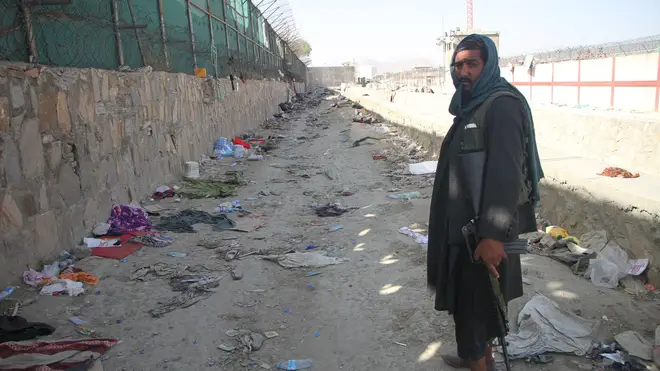
Lewis Goodall 10am - 12pm
27 August 2021, 15:15 | Updated: 27 August 2021, 17:10

The chaotic withdrawal from Afghanistan endured its most tragic day after a terror attack left scores of Afghans dead and killed US troops.
In what international forces appeared to consider inevitable, a suicide bomber detonated outside Kabul airport and horrified the world.
It brought home how dangerous the situation is there, as thousands try to escape the Taliban's rule.
The Taliban – itself no stranger to committing bloody atrocities – is not behind it.
They now rule most of Afghanistan and, technically, should be responsible for policing and security.
Instead, Isis-K, the Afghan offshoot of Isis, appears the to be the culprit, with the group itself taking responsibility.
They are rivals with the Taliban in Afghanistan.
Read more: UK evacuation of Kabul enters final hours with '150 Brits' left behind

Maajid says the Taliban have outmanoeuvred Joe Biden
At least 13 US troops and more than 70 Afghans were killed - including children, reportedly - and more than 150 people were injured in what US officials called a "complex attack".
The explosion happened at the airport's Abbey Gate. On Friday, the US military said in the confusion, a report of a second explosion at the Baron Hotel, where evacuees were being processed, were inaccurately put out.
It appears there was just one suicide attack, at the gate.
Read more: 13 US troops and scores of Afghan people die in Kabul airport suicide attack
The UK and US pledged to continue their evacuations and there are hopes they can be concluded soon, with further attacks feared.
There are thought to be between 100 and 150 Brits still left in Afghanistan, with unknown numbers of Afghans across the country hoping to flee, and defence secretary Ben Wallace has admitted "not every single (person) will get out".
About 1,000 could be left behind, he feared. The UK has airlifted about 14,000 people which Boris Johnson said constituted the overwhelming majority.
Read more: ISIS claim responsibility for Kabul attacks and identify one of the suicide bombers

The tragedy follows the abject chaos of recent weeks and months in Afghanistan.
The previous internationally-recognised government collapsed when the US began a rapid withdrawal, aiming to leave before the 20th anniversary of the September 11 attacks.
Al Qaeda's deadly plane crashes that day led to the US invading Afghanistan, when it toppled the Taliban – who ruled the country – for sheltering the terror group.
After a two-decade counter-insurgency campaign against the Taliban, and an international effort to build up a responsible Afghan government and security forces, the entire endeavour crumbled in the course of weeks.
The Taliban moved out of rural areas and began seizing urban provincial capitals, before seizing major cities and ending up on the edge of Kabul.

'Who are Isis-K?' Asian Security Professor Wali Aslam explains
President Ashraf Ghani fled, the bulk of the army seemed to have dissolved and the Taliban once more took up rule.
There are already reports that its fighters have carried out killings, including against minorities in Afghanistan, and there are fears women's rights will be severely curtailed under their new, strict interpretation of Islamic law.
Read more: British embassy workers 'left behind details of Afghan staff for Taliban to find'
The Taliban's lightning advance caught international governments off guard, with embassies hurriedly evacuated and thousands of Afghans who worked with the previous government or international forces hoping to flee.
Others hope to catch a flight out to avoid a future under the group. More than 100,000 people have been flown out since August 14.
But the situation looked precarious from the start.

Although thousands of American troops, augmented by a contingent of British paratroopers, have tried to secure the airport and help with processing evacuees, they are also reliant on Taliban cooperation.
The Taliban said it would allow foreigners to leave but recently told Afghans not to flee their rule, and instead stay at home.
There are reports they have applied crude forms of crowd control, including whippings and beatings, outside Hamid Karzai International.
But with the external policing having to come from Taliban fighters, an attack by Isis-K seemed inevitable. The UK's armed forces minister told LBC he feared an imminent threat hours before the blasts took place.
It remains to be seen if terrorists take advantage of the chaos to try another attack – and what will happen as the presence of international troops draws down ahead of the planned August 31 withdrawal from Kabul airport.
US President Joe Biden has been sharply criticised for the rapid withdrawal from Afghanistan and the collapse of the previous regime. He threatened to find those responsible for the blasts and make them "pay".
For now, it will be hoped that foreign citizens and Afghans can leave safely without further bloodshed.